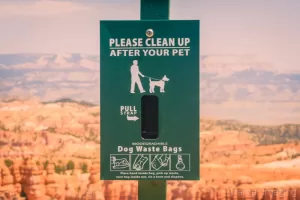How to Adventure Outdoors Without Leaving a Trace Behind
Shop

Ever been to a campsite or a hiking trail where unkind person had trashed the area before leaving? I expect that you did not enjoy the experience as much as you had hoped, especially if you had to clean up after them. Want to know what you can do to not be that person to someone else? Here we discuss the principles of Leave No Trace.
Spring is here and summer is coming. The weather is warming up and everyone is going to want to go outside and enjoy the outdoors. Camping, hiking, and vacations are going to be on everybody’s lists of things to do. The question becomes how to do these outdoor activities without destroying things for others.

Previously as a Cub Scout leader, I have been teaching the boys the principles of Leave No Trace as a part of the outdoor program. Later, as a Boy Scout leader, I continued that education at a deeper level for the boys. This program contains seven points which, if followed will prevent you from damaging the surrounding environment and also make sure that you are not that rude guy who left garbage behind.
These seven points are:
- Plan Ahead and Prepare
- Travel and Camp on Durable Surfaces
- Dispose of Waste Properly
- Leave What You Find
- Minimize Campfire Impacts
- Respect Wildlife
- Be Considerate of Other Visitors

Some of these concepts are more broad than others. As a result, there are several sub-points which may be discussed under each of these headings.
1. Planning Ahead and Preparing
Planning ahead and preparing means more than simply checking the weather report before you leave. It means following local regulations and making sure that you are prepared for emergencies as well.

2. Travel and Camp on Durable Surfaces
Camping on a durable surface seems like common sense to most people. No one wants to sleep in a muddy stream bed likely to flood over. This also means that we don’t start blazing our own trails unnecessarily. Curiosity is not a necessity nor an excuse for trail blazing.

3. Dispose of Waste Properly
Disposing of waste properly is rather simple. If you pack it in, then you also pack it out with you. Human waste needs to be buried at least 6 to 8 inches deep. Also, don’t wash dishes near a natural water source such as a stream or lake.

4. Leave What You Find
Leaving what you find means that you don’t pick the flowers, take the rocks, or anything like that. Especially don’t go removing historical artifacts. This is especially difficult for children but proper instruction and guidance will prevent too much environmental disturbance.

Please keep in mind that removing objects from a US national park is a federal crime. The list of objects includes rocks, flowers, sticks, and more. This flower was almost a victim of such a crime. I mean that literally.
5. Minimize Campfire Impacts
Minimizing campfire impact means to follow the local fire regulations. If fires are forbidden, don’t build one. Where permitted, use established fire pits. Don’t build a larger fire than you need. A simple family camp out does not require a bonfire.

6. Respect Wildlife
Respecting wildlife means that you do not approach or antagonize any of the wild animals you may see. Don’t feed them. Wild animals are not your pets and need to keep foraging for themselves. This will prevent them from dying thanks to laziness. Remember your own personal safety in the field. Speaking of pets, make sure that you control your pets at all times or don’t bring them with you at all. Excited dogs are the worst violators of not respecting wildlife.

7. Be Considerate of Other Visitors
Finally, being considerate to other visitors includes things like keeping your voice volume under control. No one likes that obnoxiously loud and rude tourist drowning out the sound of nature. Make sure to yield the trail or make room for others to pass when you encounter them. Not everyone travels or sight-sees at the same speed.

Conclusion
Following these seven simple suggestions will help you and everyone after you to enjoy your outdoor adventures. If you would like to learn more about the principles of Leave No Trace, follow this link to their website to read more about this outdoor code in detail.
Leave No Trace is not the intellectual property of Audrey Cramer nor of Cramer Imaging.
Best Sellers
Cramer Imaging Newsletter

Receive monthly updates in your inbox from us.





